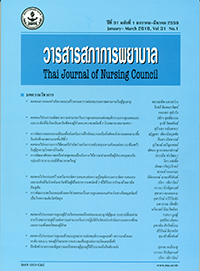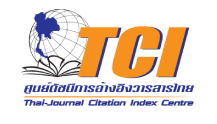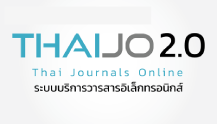การพัฒนาบทเรียนคอมพิวเตอร์ช่วยสอนเรื่องการดูแลตนเอง สำหรับชาวไทยมุสลิมที่เป็นโรคความดันโลหิตสูง
Keywords:
โรคความดันโลหิตสูง, ชาวไทยมุสลิม, บทเรียนคอมพิวเตอร์ช่วยสอน, ความรู้ เรื่องการดูแลตนเอง, hypertension, Thai Muslims, computer-assisted self-care programme, self-care knowledgeAbstract
บทคัดย่อ: วัตถุประสงค์ของการวิจัย: เพื่อพัฒนาบทเรียนคอมพิวเตอร์ช่วยสอน เรื่องการดูแลตนเอง สำหรับชาวไทยมุสลิมที่เป็นโรคความดันโลหิตสูง และศึกษาผลของบทเรียน คอมพิวเตอร์ช่วยสอนต่อความรู้และความพึงพอใจของชาวไทยมุสลิมที่เป็นโรคความดันโลหิตสูง
การออกแบบงานวิจัย: การวิจัยกึ่งทดลอง ชนิดศึกษาหนึ่งกลุ่ม วัดความรู้ก่อนและ หลังการทดลอง
การดำเนินการวิจัย: การวิจัยครั้งนี้แบ่งออกเป็น 2 ระยะ คือ ระยะที่ 1 การผลิตสื่อ บทเรียน คอมพิวเตอร์ช่วยสอน และระยะที่ 2 การทดสอบผลของบทเรียน กลุ่มตัวอย่างเป็น ชาวไทยมุสลิมที่เป็นโรคความดันโลหิตสูง เลือกกลุ่มตัวอย่างแบบเฉพาะเจาะจงจำนวน 36 ราย เก็บรวบรวมข้อมูลโดยใช้เครื่องมือ 4 ชนิด ได้แก่ แบบประเมินคุณภาพสื่อบทเรียนคอมพิวเตอร์ ช่วยสอน แบบสอบถามข้อมูลส่วนบุคคล แบบสอบถามความพึงพอใจต่อการ ใช้บทเรียน คอมพิวเตอร์ช่วยสอน และแบบทดสอบความรู้ วิเคราะห์ข้อมูลโดยใช้สถิติบรรยาย และ Paired t-test
ผลการวิจัย: ผลการศึกษา พบว่า บทเรียนคอมพิวเตอร์ช่วยสอนมีคุณภาพอยู่ในระดับ ดีถึงดีมากทุกด้าน คะแนนความรู้เฉลี่ยหลังเรียนสูงกว่าก่อนเรียนด้วยบทเรียนคอมพิวเตอร์ ช่วยสอนอย่างมีนัยสำคัญทางสถิติ (p < .001) กลุ่มตัวอย่างมีความพึงพอใจต่อการใช้ บทเรียนคอมพิวเตอร์ช่วยสอนในระดับมากทุกด้าน แสดงให้เห็นว่าบทเรียนคอมพิวเตอร์ ช่วยสอนเรื่องการดูแลตนเองสำหรับชาวไทยมุสลิมที่เป็นโรคความดันโลหิตสูง มีผลทำให้ ชาวไทยมุสลิมที่เป็นโรคความดันโลหิตสูงมีความรู้เพิ่มขึ้น
ข้อเสนอแนะ: ควรใช้บทเรียนคอมพิวเตอร์ช่วยสอนเรื่องการดูแลตนเองสำหรับชาวไทย มุสลิมที่เป็นโรคความดันโลหิตสูง ในการให้ความรู้แก่ชาวไทยมุสลิมที่เป็นโรคความดันโลหิตสูง
Abstract: Objective: To develop a computer-assisted self-care programme for Thai
Muslims with high blood pressure and to evaluate their knowledge of and satisfaction
with the programme.
Design: Two-group experimental research with a pre-test and a post-test.
Implementation: This study was conducted in 2 stages: programme development
stage and programme outcome evaluation stage. The subjects, obtained by means of
purposive sampling, consisted of 36 Thai Muslims with hypertension. Four instruments
were used for data collection: (1) a quality evaluation form for the computer-assisted
programme; (2) a personal information form; (3) a satisfaction rating form; and (4)
a knowledge evaluation form. The data were analysed using descriptive statistics and
paired t-test.
Results: Every aspect of the computer-assisted self-care programme was rated
between ‘good’ and ‘very good’. The subjects’ average post-test score was significantly
higher than their pre-test score (p < .001). The subjects also displayed a high level of
satisfaction with every aspect of the programme. All these findings confirmed the
effectiveness of this computer-assisted self-care programme in giving the subjects a
better understanding of hypertension.
Recommendations: It is recommended that the computer-assisted self-care
programme be applied to and tested on other groups of hypertension patients whose
eating habits differ significantly from Muslims'.
References
World Health Organization. (2012). New data
highlight increase in hypertension, diabetes incidence
in 2012. Available from: http://www.int/mediacentre/
news/release/2012/world_health_static_20120516/
en/index.html Access December 13, 2012.
Dept. of Health and Human Services (US). The seventh
report of the joint national committee on prevention,
detection, evaluation and treatment of high blood
pressure (JNC-7). Complete report. Bethesda (MD):
National Institutes of Health; 2003. Report No.
-5231).
Aekplakorn W, editor. The fifth report of a survey
public health Thailand by physical examination in
-2009. Nonthaburi: The Graphico systems; 2011.
Report No: 613.072.
Huangtong S, Piaseu N, Kaveevivitchai C. Case study :
Behaviors problems and barriers of blood pressure
control in persons with severe hypertension in a
community. Rama Nurs J 2013; 19(1): 193-212.
Policy and Strangy Office. (2013). Health statistics
in 2010-2012. Available from: http://bps.ops.moph.
go.th Access December 20, 2013.
Office of Social Development and Human Security
of Yala province. (2013). Social situation report
of Yala province in 2013. Yala: Office of Social
Development and Human Security of Yala province;
Nima Y, Hasuwanakij S, editors. Medical and patient
care corresponding to Muslim culture. 2nd ed. Songkla:
Health Systems Research Institute of The Southen;
Samoh M. Health beliefs and self-care of hypertension
patients Tumbol Puyud Amphoe Muang Changwat
Pattani [dissertation]. Pattani: Prince of Songkla
Univ.; 2008.
Phantapak T. Factors influencing of health promotion
behaviors in Muslim elders with hypertension
[dissertation]. Songkla: Prince of Songkla Univ.; 2008.
Komrattanapanya K, Khamrat C, Dejthai T. The
effectiveness for complications prevention in
essential hypertension patients Bang Sai distric
Ayutthaya province. KKU Res J 2010; 15(10):
-909.
Netnarongporn S. A survey of experimental and quasiexperimental
nursing research among hypertensive
patients in Thailand [dissertation]. Bangkok: Mahidol
Univ.; 2008.
Songkram N. Multimedia for leaming: design and
development. 2nd ed. Bangkok: V print; 2011.
Chaweethamwat A. Development of computer-assisted
instruction on knowledge of congenital heart disease
for school-aged children with congenital heart disease.
[dissertation]. Bangkok: Mahidol Univ.; 2012.
Takabayashi K, Tomita M, Tsumoto S, Suzuki T,
Yamazaki S, Honda M. Computer-assisted instructions
for patients with bronchial asthma. Patient Educ
Couns 1999; 38(3): 241-8.
Rosenstock IM. Historical origins of the health belief
model. Health Educ Behav 1974; 2(4): 1-47.
Gagne R, Briggs L, Wager W. Principles of instruction
design. 4th ed. Fort Worth (TX): HBJ college; 1992.
Mohamed SB, Silla C, Jocelyne J. A comparative
study between a computer-aided education (ISIS)
and habitual education technique for hypertensive
patients. JAMIA 1994; Nov(5-9): 10-4.
Kaveevivitchai C. Development of multimedia
computer-assisted learning units on adult physical
examination for nursing students [dissertation].
Bangkok: Mahidol Univ.; 2009.
Lee J H, Park MH. The effects of an educatiom
program for safe drug use in the rural elderly. Journal
of Korean Academy of Nursing 2007; 37: 295-304.
Neafsey PJ, Anderson E, Coleman C, Lin AC, M,lan
EC, Walsh S. Reducing adverse self medication behaviors
in older adults with the next generation personal education
program (PEP-NG): Design and methodology. Patient
Preference and Adherence 2009; 3: 323-34.
Sullivan RL, Wircenski JL, Arnold, SS, Sarkees MD.
Creating a positive training Climate: In a practical
manual for the design, delivery, and evaluation of
training. Rockville (MD):Aspen;1990.






